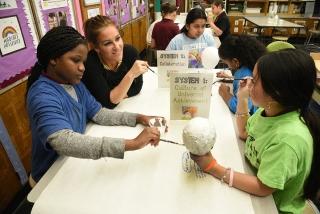Like most educators in professional development sessions, teachers at PS 249 in Flatbush, Brooklyn, discuss theories and best practices. But at PS 249, teachers also get a unique opportunity to test out the strategies they learn on students right away.
In a traditional PD session, teachers might observe each other modeling a strategy and then go back to try it in their own classrooms during the school day. But educators at PS 249 wanted to get immediate feedback during professional learning sessions that would also benefit students.
So staff members at PS 249 used the greater flexibility they have as a PROSE school to put to creative use the designated time in the workday for school-based professional development.
Teachers meet in grade-level “achievement teams” to target a particular area of instruction. This year, the focus for the whole school is writing — in particular, how to hold more effective writing conferences with students.
“The first three years, we struggled to find a vertical weakness that everyone could work on,” says Lara Terry, a data specialist and the chapter leader. “We found that when grades worked on different things, it was difficult to monitor progress toward our goal and it wasn’t as cohesive.”
On Mondays after school, achievement teams meet to plan and discuss. On Tuesdays, they meet with students — those who are already enrolled in the school’s after-school program — in a “fishbowl” scenario, in which one teacher models a strategy while other teachers observe.
On a recent Tuesday, the kindergarten team watched lead teacher Julie Jay encourage three students to label their pictures with the initial sounds they heard.
“Before, we were all doing different things, and we didn’t know which ones worked and which didn’t,” says kindergarten teacher Haslee Cameron. “Now I use the strategies I see Ms. Jay model and give students resources to use, so we’re accountable for checking back in and they’re accountable for those strategies.”
The close collaboration results in the application of best practices across the school.
“Something our school strives for is consistency,” says Terry. “So working together toward a goal feels really good.”
This hands-on instructional practice is part of the staff’s three-pronged approach to professional learning during the work week that also includes intervention for struggling students and enrichment for older students. Those two prongs give paraprofessionals and cluster teachers — who are often underserved by traditional PD — the opportunity to do meaningful work during PD time.
Small groups of struggling students receive intervention from specially trained staff members, including paraprofessionals who work with at-risk kindergartners to learn their letters and sounds. Cluster teachers, who may not naturally fit in to the makeup of the grade-level teams, instead meet with students in enrichment clubs. The school’s dance teacher teaches tap; the music teacher is teaching students to play the ukulele; the art teacher leads a papier-mâché project.
Clubs cycle three times during the school year. Yaffa Rasowsky, the school’s art teacher and the arts leader, maintains a detailed spreadsheet of students’ activities to make sure every student has a chance to participate in at least one special activity.
“It’s a chance for them to work collaboratively and access materials and techniques we can’t always use during the school day,” says Rasowsky.
